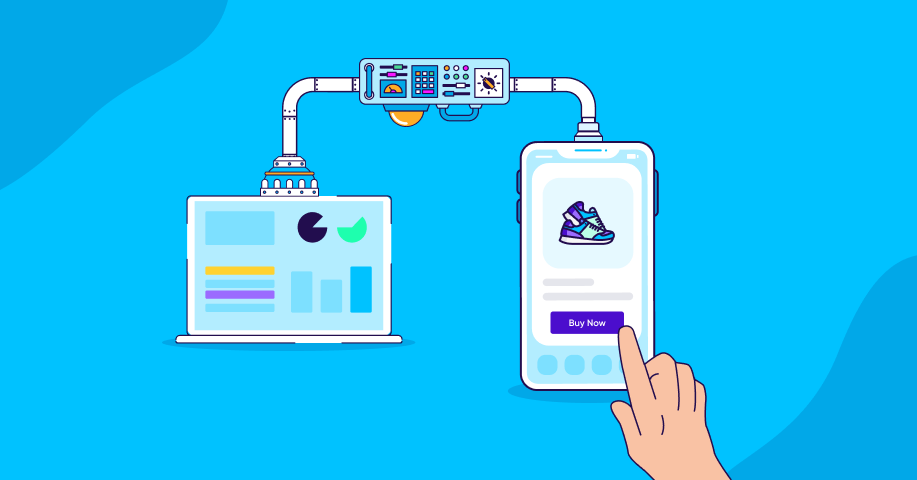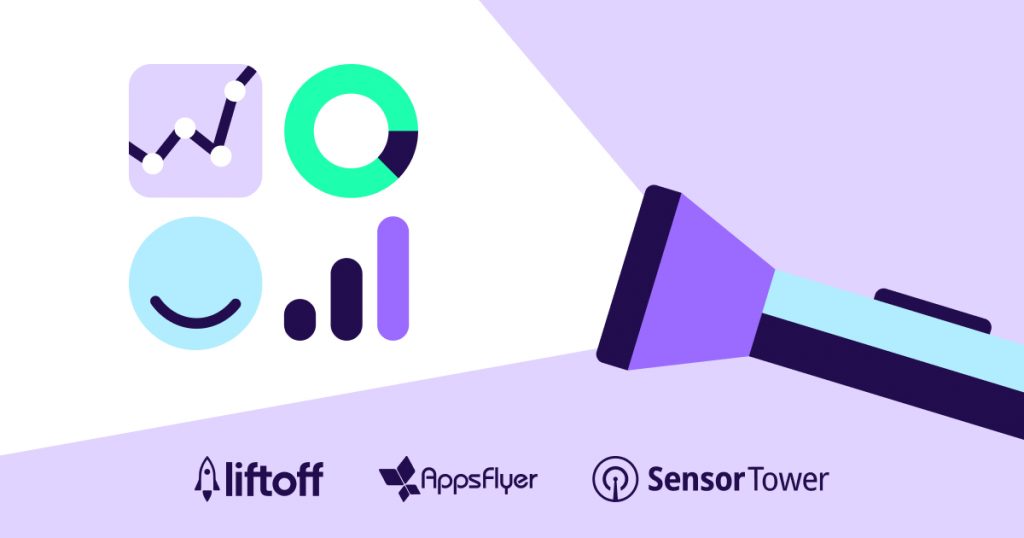
Introduction
No conversation about the future of advertising is complete without mentioning automation and artificial intelligence (AI). If you want to sound extra smart, throw some acronyms like DSP, DMP, and RTB into the mix (don’t worry, you’ll learn what they all mean in this guide).
As screen time has become an increasing part of our everyday lives, advertising is evolving to reach more people, faster, and cheaper. But advertising isn’t what it used to be. There’s more competition than ever to not only reach tech-savvy consumers, but also to talk to them in a way that resonates with their niche interests.
Enter: programmatic advertising.
This technology means brands can automate media transactions, allowing publishers to measure the attention they generate in real time. Programmatic advertising promises to deliver highly personalized messages, at the right time, to the right people, using automation and AI.
In this guide, we’ll share a comprehensive introduction to the programmatic ecosystem, breaking down all of its key components and how they relate to one another. With the insights you’ll gain, you’ll be better equipped to add programmatic marketing to your digital marketing toolkit.

Chapter 1
What is programmatic advertising?
Programmatic advertising is an automated media-buying process, powered by AI and machine learning, that enables advertisers to segment audience data, identify the most efficient placements, run auctions, and sell digital ad impressions in real time.
It uses a combination of first-, second-, and third-party data — including keywords, location targeting, public records, registration data, and surveys — to buy and sell online advertising in open and private digital marketplaces.
How prevalent is programmatic advertising?
Over the past 20-plus years, the Interactive Advertising Bureau (IAB) has found that “programmatic advertising has become a key element in most digital ad budgets for its scale and efficiency in targeting and placing digital advertising”.
According to Statista, global programmatic ad spend totaled $493B in 2022 and is expected to rise to $557.56B in 2023. And in 2022, 75.6% of programmatic digital display advertising in the US was invested in mobile.
The explosive growth in programmatic is a result of how it has streamlined the advertising process at scale. In the past, the media-buying process was slow and manual, involving direct sales between publishers, agencies, and advertisers to negotiate for the best ad inventory. Advertisers and publishers worked with agencies as middlemen to negotiate placement and time, and carry out audience research.
What isn’t considered programmatic?
Ads that are sold directly, with predetermined pricing and timeframe, are not considered to be programmatic. Programmatic advertising uses automation to help both buyers and sellers to ultimately reduce overhead, allocate budgets to more impactful placements, and drive more revenue for publishers to sell inventory quickly.
What is the history of programmatic advertising?
The dawn of digital advertising can be traced back to a single pixelated rectangle. In 1994, telecoms giant AT&T placed the internet’s first banner ad on the online magazine HotWired, the predecessor to WIRED. It read: “Have you ever clicked your mouse right here? You will.”
Like cavemen burning their hands in a newly discovered fire, early internet users clicked the ad at a whopping 44% click-through rate. But there was no way to measure the ad’s effectiveness in reaching relevant customers. The same ad was displayed no matter who visited the site. Manual media placements limited the opportunities for truly personalized communications.
As the internet became more accessible, so did the demand for digital advertising. In 1996, DoubleClick, which is considered as the first ad server, was founded. It was acquired by Google in 2007 for $3.1 billion, which catalyzed the start of more ad servers in the ecosystem including Advertising.com, Zeo, and Ad Stream.
Soon after that, Google launched its proprietary ad product, Google AdWords, in 2000. This eventually led to the release of Google’s Display Network (GDN) in 2013.
In around that same timeframe, Google AdEx, Microsoft AdECN, Rubicon Project, and Yahoo’s Right Media built out real-time bidding (RTB) software that combined the Data Service Providers (DSP), Supply Side Platforms (SSP), and ad exchanges in one place.
Today, programmatic is a force to be reckoned with in the world of advertising, making up 72% of the total market of digital displays.
What are the programmatic advertising channels?
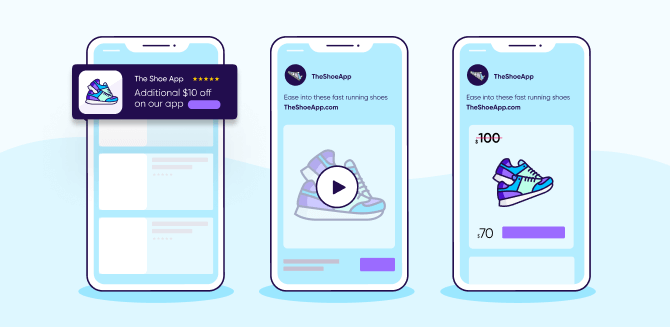
With great technology comes more choice! Programmatic advertising is used across seven main advertising channels: display, video, social, audio, native, digital out-of-home, and in-app advertising. Let’s go through each one.
Display ads
The most common form of programmatic advertising, these are visual ads placed in the header, footer, or sidebar of websites or apps. Display ads can be dynamically optimized, updated, and personalized based on user data.
Video ads
Programmatic video advertising reached about $62.96B in 2022 and is projected to grow to $74.88B in 2023. There are three main types of video ads available to advertisers.
In-stream video ads are shown within the video player. This is by far the most common type of video advertising, and advertisers can choose from options including:
- Pre-roll: ad shows before video plays
- Mid-roll: ad runs in the middle of video content
- Post-roll: ad runs after the video ends
- YouTube bumper: brief but non-skippable ads shown before video
Out-stream video ads appear within articles natively or as pop-ups.
In-display video ads show up in the search results or as a sponsored video recommendation.
Social ads
Whether it’s Facebook, Instagram, Snapchat, Pinterest, TikTok, or Twitter, advertising on social media can be bought through APIs (application programming interfaces, which enable computer programs to talk to each other) or through a demand-side platform (DSP) integrated with them (more on this later).
Native ads
Native ads are baked into the website or app they’re being served on, for seamless viewing. Instead of a loud banner pop-up video ad blaring in your face, native ads blend naturally into the content, providing a better user experience. Native ads can be programmatically placed in the header, footer, sidebar, or within the content itself.
The most common native ad formats are:
- In-feed units: ads appear within feeds, like paid placements in editorial homepages that look like an article.
- In-article ads: appear within paragraphs of an editorial piece.
- Paid search units: ads appear at the top of the search results, looking similar to organic search results.
- Recommendation widgets: a recommendation of a similar piece of content that the user may like.
Audio ads
Podcast placements, Spotify ads, and Pandora ads are a few ways advertisers can buy ads programmatically. While most podcasts and audio shows rely on manual, private ad deals for their primary placements, programmatic ads can be bought at scale for freemium platform users.
Digital out-of-home (DOOH)
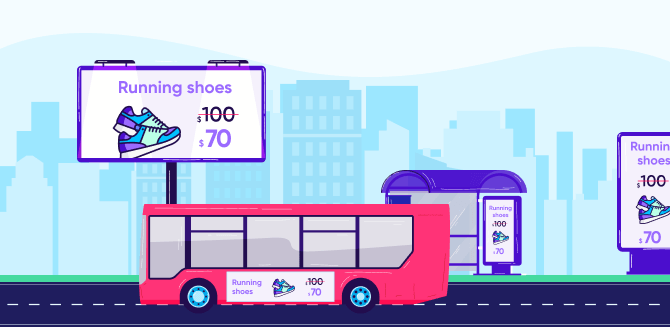
Out-of-home advertising, or OOH for short, used to involve visual, static signage like a mall poster on a highway billboard. However, as digital signage has become more affordable to mass produce, OOH now provides advanced targeting and measurement tools that weren’t ever possible before.
Unless you live in Sao Paulo (where outdoor advertising is banned!), you’ve encountered a DOOH ad in the past month, if not week! DOOH placements can be bought and sold programmatically, which can be particularly powerful when paired with strategies like geofencing (where relevant ads are programmed to show up as a user enters a particular geographical area).
The new popular kid in town: in-app programmatic advertising
Given that the average consumer spends four to five hours per day engaging with mobile apps, it’s worth taking a closer look at how programmatic advertising in mobile apps actually works.
Web-based ads work within search, banners, videos, and classifieds, but in-app ads have different display formats, size requirements, and display durations.
The most common formats are bottom-locked banners, which offer greater reach, and interstitials, which pop up between user actions, such as in between levels of a game.
Rewarded ads are a way of integrating into a gaming context where viewers can advance after viewing an ad. Also, while ad-blockers are now built into certain browsers, in-app ads are not (yet) vulnerable to ad-blocking software.
Social, news, and gaming apps have some of the highest mobile user penetration, and offer strong potential for return on investment (ROI) from in-app programmatic advertising.
How much does programmatic cost?
The beauty of programmatic is affordability. The automation process has made it significantly cheaper to advertise compared to direct ad-buying. Programmatic ads are sold on the following models:
- CPM (cost per mille), which means cost per thousand impressions.
- CPC (cost per click)
- CPA (cost per action)
- CTC (click-through conversions)
CPM is the most common model for selling programmatic ads. But the price you pay will depend on competition, inventory scarcity, reach, and targeting specificity. Since programmatic functions within an automated auction, a small, highly competitive target audience will be much more costly than a broad, general audience.
With so many variables to consider, an industry-average CPM can’t adequately represent whether or not it’s an effective campaign for you. Some publishers may also sell premium inventory programmatically, which may be more expensive than other forms of advertising.
Don’t forget the tech fees
As the adage goes, never do something you’re good at for free. As much as the programmatic process has streamlined the entire media-buying process, technology fees are taken from publisher revenues. Fees vary from partner to partner, and the more intermediaries you have, the more you’ll have to factor into your total ROI calculations.

Chapter 2
How does programmatic benefit advertisers?
In addition to streamlining the advertising process, programmatic advertising offers a host of other benefits. It provides a wider range of inventory, targeting, and strategic options to enable advertisers to reach their ideal audiences more accurately, quickly, and affordably.
Efficiency and lower CPMs
Like the invention of the assembly line leading to the mass production of the Ford Model T, programmatic advertising has streamlined the way advertisers can reach multiple audiences with unique messaging and creatives simultaneously. This has led to cutting out expensive middlemen and costly buying and selling practices, effectively lowering CPMs across the board.
Cast a wide net in-home and out-of-home
Programmatic advertising has come a long way in terms of its capabilities and adoption. With 72% of all digital ad displays now being powered programmatically, advertisers can reach a massive audience accurately and quickly.
Faster, transparent insights
What’s better than more reach? More…. timely reach. The time from bid to delivery is crucial when you want to show up at the right places at just the right point in f the buyer’s journey. In addition to showing up faster, programmatic lets advertisers see immediate, measurable results, enabling nimble campaign fine-tuning, and continuous optimization. And with the help of AI, audience targeting is only getting smarter.

Chapter 3
The programmatic advertising ecosystem: how does it work?
Traditional media buying required you to hire an advertising agency to identify the right spot, negotiate its purchase, manage your ad placement, and measure performance. Just like when you used to have to call a stockbroker on Wall Street to buy or sell stocks.
But, just as we can trade stocks through apps and robo-advisors today, programmatic has transformed media buying. Trading desk software makes it accessible and easy to buy ads programmatically. As a result, more advertisers are bringing the task in-house, minimizing overhead, and making the process highly controllable and transparent.
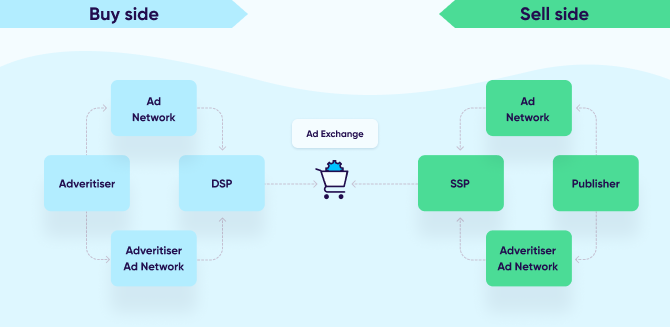
Programmatic advertising is a complex ecosystem of interconnected players directing the flow of data and transactions. To better understand how the transactional process works, let’s get to know each player in the ecosystem.
Just like how Wall Street has the New York Stock Exchange, the programmatic marketplace is called an ad exchange. It’s a digital trading floor where advertisers can buy ad space from various ad networks through their software interface. There are two opposite ends of an ad exchange: buy side and sell side.
Buy side
As the name suggests, the buy side is responsible for buying ad placements from the sell side. We have four key players on the buy side: demand-side platforms (DSPs), data management platforms (DMPs), advertiser ad networks, and advertisers.
A demand-side platform (DSP) is the technology that enables advertisers to buy ads programmatically on publisher websites and apps that are available on ad exchanges and ad networks.
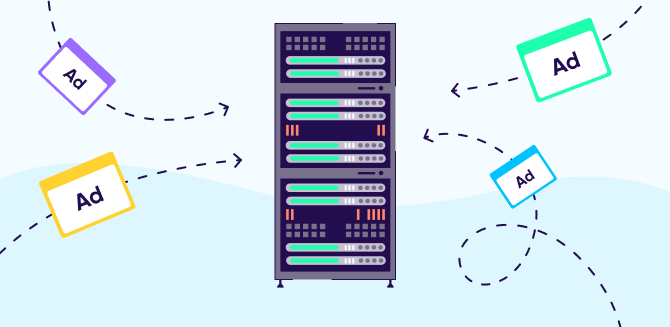
Every DSP is connected to a Data Management Platform (DMP). A DMP collects and organizes first-, second-, and third-party data., and is the engine that sorts the data that fuels ad-buying decisions. Technically, platforms like Facebook and Google Ads are a type of DSP that exclusively sell their own inventory.
Sell side
Now we move on to the sell side: the parties that help sell ad space to the buy side. The sell side includes publishers, ad networks, and supply side platforms (SSP).
Publishers are digital publications that have ad inventory space to sell on ad exchanges like WIRED, Reuters, the Economist, and Conde Nast.
An ad network is an aggregator platform that pools unsold ad space from a number of publishers, and offers that inventory to advertisers at a set rate (often discounted). Keep in mind that ad networks do not operate programmatically themselves.
Supply-side platform (SSP) help publishers automatically and efficiently manage the sale of their inventory to multiple buyers in order to maximize their inventory yield. SSPs often provide user-friendly interfaces, analytics, reporting capabilities, header bidding, yield optimization, and inventory management.
DSPs communicate with SSPs to understand what inventory is available for what price. SSPs enable publishers to sort ads by advertiser, format, audience, and rates.
Third-party services
These are the partners who help facilitate the relationship between the buy side and the sell side.
Ad verification firms integrate with DSPs to ensure viewability, brand safety, and traffic metrics are accurate.
Measurement and attribution partners (MMP) deduplicate data, measure reach and frequency, and ensure the campaign data is accurate.
Data clean rooms are shared first-party data pools from multiple trusted sources. They provide anonymized data collaboration without exposing the source, preserving consumer privacy.
What’s the difference between real-time bidding and programmatic advertising?
Real-time bidding (RTB) is the process where advertisers can place bids in an auction for specific ad space, automatically in real time — we’re talking milliseconds.
RTB is a programmatic process. Programmatic advertising is the umbrella term that encompasses all marketing activity within the programmatic ad exchange.
Programmatic advertising process: a walkthrough
When you started reading this article, you probably had no idea what RTB, SSP, or DSP meant. Now that you’ve made it this far, let’s go through a step-by-step breakdown of how the process works.
- A visitor clicks on a website or a mobile app.
- A bid request is sent to an ad exchange with information on the website or app, along with opted-in visitor data (demographic, contextual, behavioral, device, ONLY if a user has given tracking permission).
- The website or app owner puts the ad impression up for auction on the supply-side platform (SSP).
- The opted-in visitor information is then matched against available advertisers.
- Advertisers on the demand-side platform (DSP) offer bids for the impression.
- The highest bidder wins the ad impression.
- The ad is served to the user on the website or app.
- Ideally, the user clicks on the ad and converts. If not, retargeting tactics like “sticky” ads can be used to encourage them to convert at a later time.

Chapter 4
Auction types of programmatic advertising
The traditional media buying process is long and laborious, involving RFPs, pitching, and negotiations — which leaves a ton of room for high overhead costs and human error. Here are the four auction types that have helped streamline the process from the top down.
Real-time bidding (RTB)
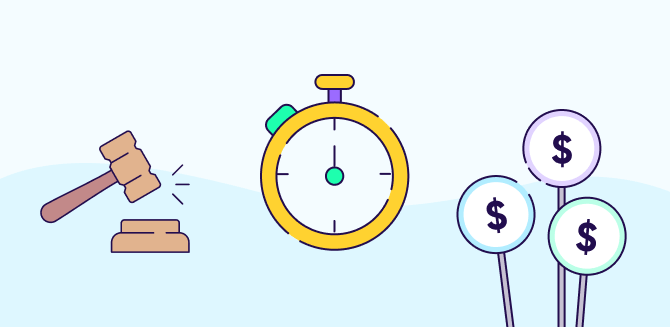
Real-time bidding (RTB), also known as open auction or open marketplace, is the most common programmatic auction type — in fact, many marketers think it’s the only one.
With RTB, inventory is available to everyone and is awarded to the highest bidder in real time. Marketers place a maximum bid and set maximum budgets for an ad campaign. The winner of the auction doesn’t have to pay their full bid price, but one cent more than the second-highest bidder.
Pros of real-time bidding:
- Easy to set up
- Pricing model helps marketers maximize their revenue without overpaying market rates
- Ubiquitous in the industry
- Available to everyone
- Large inventory pool
- Works fast
Cons of real-time bidding:
- Lack of transparency in placements
- Usually reserved for large, top-of-funnel campaigns
- No guarantees that ad spaces will be filled, because a buyer is required at a designated price
- Lack of control and visibility of placements can compromise brand safety
Private marketplace (PMP)
The private marketplace (PMP) marries RTB with direct deals. It uses the RTB auction method, but operates in a closed auction only available to hand-picked advertisers. Private marketplaces offer the option to bypass open ad exchanges, with pre-negotiated deal terms.
By plugging directly into a publisher’s ad inventory, buyers can bid for placements based on variables like audience data, content type, or a number of different impression attributes specifying when and where an ad is seen.
Pros of PMPs:
- Maximum control over inventory and where your ads show
- Access to premium first-party data
- Premium and exclusive placements
Cons of PMPs:
- Publishers don’t have to guarantee impression volume
- Advertisers aren’t required to purchase inventory
- Not immune to ad fraud
Programmatic guaranteed
With programmatic guaranteed, also known as programmatic direct, advertisers and publishers negotiate inventory, prices, audience, and frequency capping on an individual basis. While there is no auction, the ad is run programmatically.
This is a way to buy a guaranteed number of impressions on specific websites or mobile apps, and tends to be structured with a fixed-price agreement rather than an auction.
This type of programmatic advertising is most common for “premium” display formats, like full-page takeovers. Because it’s so expensive, it’s used when advertisers need to know exactly who is seeing their ad, where, and in what context.
Pros of programmatic guaranteed:
- The most brand safe
- Highest level of transparency
- Exclusive deal not available to other brands or competitors
Cons of programmatic guaranteed:
- Negotiation process can be long
- Inventory is not available to most
- More expensive than other forms
Spot buying and preferred deals
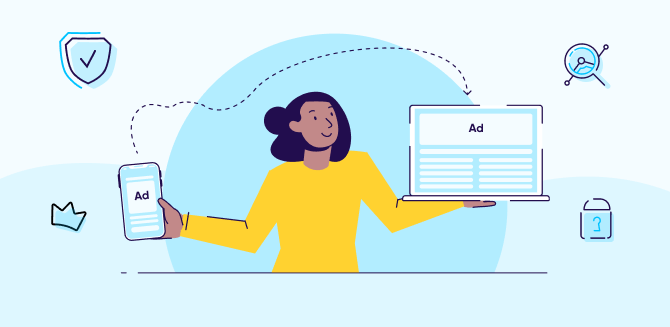
With spot buying, also known as preferred deals, advertisers are informed of a fixed price of available inventory in a private marketplace before it’s made available in an open auction.
Pros of preferred deals:
- More precise revenue expectations
- Lowest risk of ad fraud
- Securing premium inventory faster is a competitive advantage
Cons of preferred deals:
- May require lengthy negotiations and pitches
- Advertisers can back out of deals and leave unbought ad inventory
- Reserved for big publishers
Self-service vs. managed Service
Advertisers have different goals, budgets, and resources, which means there is no auction type that works for everyone. Those who prefer a hands-off approach, and can afford to pay, may prefer managed services from agencies that will do it all. Others who want more control and have smaller budgets may choose to bring the process in-house with a self-service option.

Chapter 5
Trends and best practices for 2023
While the last few years have been notoriously unpredictable, there are some clear trends emerging. Let’s go through the trends to expect in the coming year.
Cable cutters are a hot commodity
There are more SVOD (subscription video on demand) subscriptions in the US than there are people, and the number of cable-cutters is showing no signs of slowing down. And where the attention is, advertisers will follow. The mass adoption of subscription video services has created a massive inventory for video ads to be bought and sold programmatically.
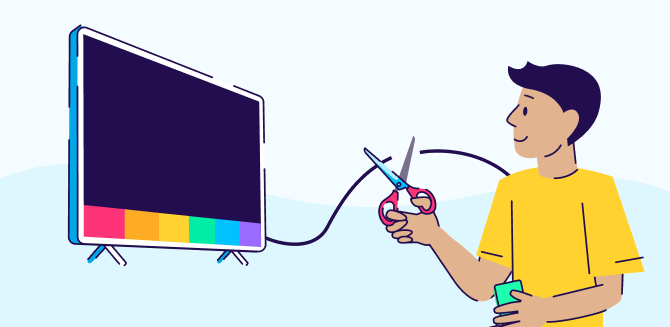
Better DOOH experiences
Whereas previously you just saw static ads along the highway, modern digital out-of-home (DOOH) technology provides features like analytics, geofencing, touch screens, and augmented reality to create more relevant and memorable ad experiences. It explains why DOOH spend is projected to reach $17.77B in 2023. And eMarketer predicts more than $1 in $4 spent on DOOH will be bought and sold programmatically.
The rise of the robots?
The public release of ChatGPT has taken the marketing world by storm. While it won’t cause the next industrial revolution, as some marketing gurus may claim, it certainly marks a massive milestone for the advancement of AI technology. As the data pool continues to grow, AI will become smarter and better at analyzing and pairing the right audiences with the right placements.
Will AI take over? No, but it will replace the redundant and manual tasks that made the media-buying process unnecessarily slow and expensive.
Native contextual ads
Dramatic changes to privacy policies will force advertisers to shift budgets to contextual ads. These ads are placed based on the content of the pages, videos, or webpage and now that they can be programmatically bought, they can be tailored to both the user and the placement at scale.
This enables advertisers to also take advantage of native contextual ads, which are nested into content seamlessly on websites without standing out like a sore thumb. These ads don’t require cookies or customer data, are fully GDPR compliant, and provide a much better user experience than traditional banner ads.
Best practices for programmatic success
Invest in your creatives
As contextual advertising takes center stage, relevant creatives will become more important than ever. Programmatic allows advertisers to deliver dynamic and relevant creatives in real time, such as advertising your BBQ app in areas where good weather is forecast.
Mix and match
Experiment with different combinations of targeting options, like native ads with contextual targeting. But before you do, ensure you’re measuring the right metrics across all your campaigns, holistically.
Don’t be a robot
It’s one thing to let your ads be run by robots, but there’s no need to sound like one! The best way to improve ad performance is to do your research, and be an expert on your target audience. Go beyond demographic data and look into what they’re reading, what’s relevant to them, and even what they’re most fearful of.
Minimize ad fraud
As far as programmatic has come, ad fraud is still one of the major threats to its success. eMarketer’s ad measurement report estimates fraud will cost digital advertisers from $6.5 billion to $19 billion each year. Take the necessary precautions, like working with an MMP and ad verification firms to ensure you’re getting what you pay for.

Key takeaways
So, that’s it — everything you need to know about programmatic advertising. Let’s finish with a quick round-up the key points:
- Programmatic advertising is an automated media-buying process that uses AI and machine learning to segment audience data, identify efficient placements, run auctions, and sell digital ad impressions in real time.
- Programmatic advertising has become ubiquitous for its scale and efficiency, reaching about $99.43 billion in ad spend in 2022 and forecast to keep on growing. It’s used across multiple channels, both in and out of home.
- Programmatic advertising is a complex ecosystem of interconnected players directing the flow of data and transactions. They can be separated into three categories: sell side, buy side, and third party.
- Real-time bidding (RTB), also known as open auction or open marketplace, is the most common programmatic auction type. It’s open to all and the spot goes to the highest bidder.
- To be successful with programmatic, invest in creatives, experiment with different combinations of targeting options, research your audience, and minimize ad fraud.

